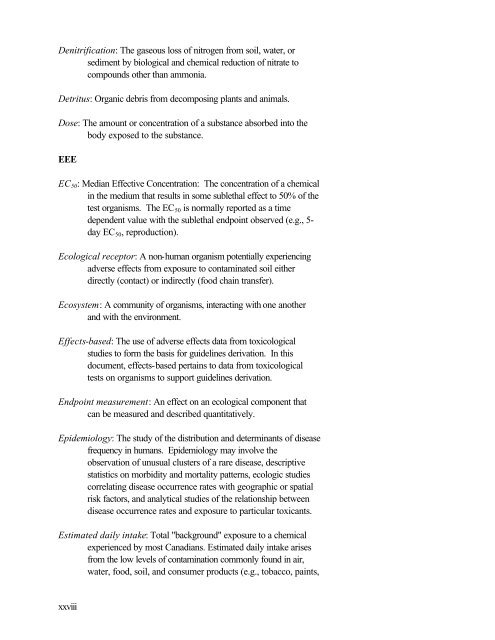Protocol for the Derivation of Environmental and Human ... - CCME
Protocol for the Derivation of Environmental and Human ... - CCME
Protocol for the Derivation of Environmental and Human ... - CCME
Create successful ePaper yourself
Turn your PDF publications into a flip-book with our unique Google optimized e-Paper software.
Denitrification: The gaseous loss <strong>of</strong> nitrogen from soil, water, or<br />
sediment by biological <strong>and</strong> chemical reduction <strong>of</strong> nitrate to<br />
compounds o<strong>the</strong>r than ammonia.<br />
Detritus: Organic debris from decomposing plants <strong>and</strong> animals.<br />
Dose: The amount or concentration <strong>of</strong> a substance absorbed into <strong>the</strong><br />
body exposed to <strong>the</strong> substance.<br />
EEE<br />
EC 50 : Median Effective Concentration: The concentration <strong>of</strong> a chemical<br />
in <strong>the</strong> medium that results in some sublethal effect to 50% <strong>of</strong> <strong>the</strong><br />
test organisms. The EC 50 is normally reported as a time<br />
dependent value with <strong>the</strong> sublethal endpoint observed (e.g., 5-<br />
day EC 50 , reproduction).<br />
Ecological receptor: A non-human organism potentially experiencing<br />
adverse effects from exposure to contaminated soil ei<strong>the</strong>r<br />
directly (contact) or indirectly (food chain transfer).<br />
Ecosystem: A community <strong>of</strong> organisms, interacting with one ano<strong>the</strong>r<br />
<strong>and</strong> with <strong>the</strong> environment.<br />
Effects-based: The use <strong>of</strong> adverse effects data from toxicological<br />
studies to <strong>for</strong>m <strong>the</strong> basis <strong>for</strong> guidelines derivation. In this<br />
document, effects-based pertains to data from toxicological<br />
tests on organisms to support guidelines derivation.<br />
Endpoint measurement: An effect on an ecological component that<br />
can be measured <strong>and</strong> described quantitatively.<br />
Epidemiology: The study <strong>of</strong> <strong>the</strong> distribution <strong>and</strong> determinants <strong>of</strong> disease<br />
frequency in humans. Epidemiology may involve <strong>the</strong><br />
observation <strong>of</strong> unusual clusters <strong>of</strong> a rare disease, descriptive<br />
statistics on morbidity <strong>and</strong> mortality patterns, ecologic studies<br />
correlating disease occurrence rates with geographic or spatial<br />
risk factors, <strong>and</strong> analytical studies <strong>of</strong> <strong>the</strong> relationship between<br />
disease occurrence rates <strong>and</strong> exposure to particular toxicants.<br />
Estimated daily intake: Total "background" exposure to a chemical<br />
experienced by most Canadians. Estimated daily intake arises<br />
from <strong>the</strong> low levels <strong>of</strong> contamination commonly found in air,<br />
water, food, soil, <strong>and</strong> consumer products (e.g., tobacco, paints,<br />
xxviii
















